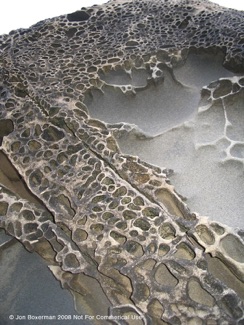Evolution
Summary
Visual and morphometric data of tafoni in sandstone in a coastal setting reveals the following:
-
•Tafoni initiate with a pit, preferentially deepen, coalesce by wall breaching, and degrade, or form more voluminous caverns often with tafoni nesting inside.
-
•Tafoni are selective, for instance, they do not form on all rock types in all climatic settings.
-
•In this intertidal setting, rates of cavity deepening can be rapid, up to 1.4 mm/year, but most tafoni deepening rates we measured range from about 0.1 to 0.6 mm/year. On average, we estimate it takes about 100 to 400 years for a pit to enlarge into a well developed Stage II tafone more about 4 cm deep.
-
•Wall breakdown may signal an end or at least a slow down in the rates of deepening, and wall thinning between cavities is significantly slower than backwall deepening.
-
•Sometimes walls emerge from the host rock itself as the rock surface around these more resistant wall areas preferentially lower. In other instances, biological coatings may inhibit lowering wall breakdown.
-
•In coastal settings, tafoni seem to retreat in layers and tafoni weathering processes seem to account for a significant proportion of coastal retreat in some coastal areas of Northern California.
The following animation depicts a simplified representation of this stage model over time.
When walls separating tafoni become thin (< 3 mm), they weaken and break, conjoining neighboring cavities either gradually or more piecemeal. Once the wall has been removed, the energy in the system transfers from deepening cavities to wearing down the remnant cavity walls. After tafoni walls break and the cavities converge, they leave behind intricate angular walls and meandering tendrils, relicts of their former existence. Sometimes these tendrils persist on the landscape and can link to adjacent tendrils, effectively forming new enclosures. It seems plausible that remnant tafoni walls lower to the level of the back of the once extant cavities.
Note that in some time-series photographs some walls do in fact emerge from the host rock itself, as the surface lowers around these more resistant infilled fracture planes.
Tafoni may reach a period of maximum stability, prior to coalescence (stage II); at which point tafoni achieve a critical depth, appear well-rounded, and the frequency of tafoni per surface area is stable. This stage may also represent a period when tafoni are self-organized, when the tafoni pattern emerges due to intrinsic properties of the rock rather than to factors outside this system (Turkington and Phillips, 2004; McBride and Picard, 2004).
Self-patterning in complex geological systems “cannot as a rule be proven by experiment, [and it is] often difficult even to establish that they are true cases of self-patterning, let alone identify the mechanisms involved” (Merino, 1984). Nonetheless, self-organization in geological systems is displayed, for example, in concentric iron banding (Liesegang) and realted boxwork patterns; schistosity and foliation in metamorphic rocks; and zoning in plagioclase feldspar (Ortoleva, 1984).
Perhaps development of the tafoni rock weathering pattern is a self-organized geological system, an emergent pattern in nature that persists given the appropriate lithologic and climatic conditions.





The information presented on this website was gathered while completing a master’s of geoscience thesis at San Francisco State University (Boxerman, 2006), with the generous support of the SFSU geosciences department, my faculty advisors, the SEPAL Partnership program, the California State Parks, the prior work of tafoni researchers, and my family and friends.
This work would not have been possible had Ray Pestrong, my thesis advisor, not the foresight to make precise measurements and close-up photographs of hundreds of tafoni features more than 30 years ago. His guidance, insights, perspective, and love for the Earth has played a formative role in how I have come to appreciate this emergent pattern in nature.

